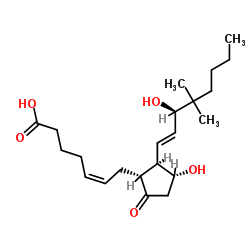16,16-Dimethyl prostaglandin E2

16,16-Dimethyl prostaglandin E2 structure
|
Common Name | 16,16-Dimethyl prostaglandin E2 | ||
|---|---|---|---|---|
| CAS Number | 39746-25-3 | Molecular Weight | 380.518 | |
| Density | 1.1±0.1 g/cm3 | Boiling Point | 541.3±50.0 °C at 760 mmHg | |
| Molecular Formula | C22H36O5 | Melting Point | -85.6ºC | |
| MSDS | Chinese USA | Flash Point | 295.2±26.6 °C | |
| Symbol |


GHS02, GHS07 |
Signal Word | Danger | |
|
Lysophosphatidic acid enhances survival of human CD34(+) cells in ischemic conditions.
Sci. Rep. 5 , 16406, (2015) Several clinical trials are exploring therapeutic effect of human CD34(+) cells in ischemic diseases, including myocardial infarction. Unfortunately, most of the cells die few days after delivery. Herein we show that lysophosphatidic acid (LPA)-treated human ... |
|
|
Prostaglandin E2--mediated relaxation of the ductus arteriosus: effects of gestational age on g protein-coupled receptor expression, signaling, and vasomotor control.
Circulation 110(16) , 2326-32, (2004) In the preterm newborn, a patent ductus arteriosus is in large part a result of the increased sensitivity of the immature ductus to prostaglandin E2 (PGE2). PGE2 acts through 3 G protein-coupled receptors (EP2, EP3, and EP4) that activate both adenyl cyclase ... |
|
|
Prostanoids regulate angiogenesis acting primarily on IP and EP4 receptors.
Microvasc. Res. 101 , 127-34, (2015) Angiogenesis is regulated by numerous activators and inhibitors, including prostanoids. Although many studies have identified their roles in inflammation, regulatory functions of prostanoids in angiogenesis are poorly understood. Here, we compared the activat... |
|
|
Discovering chemical modifiers of oncogene-regulated hematopoietic differentiation.
Nat. Chem. Biol. 5 , 236-43, (2009) It has been proposed that inhibitors of an oncogene's effects on multipotent hematopoietic progenitor cell differentiation may change the properties of the leukemic stem cells and complement the clinical use of cytotoxic drugs. Using zebrafish, we developed a... |
|
|
Chronic prostaglandin E2 treatment induces the synthesis of the pain-related peptide substance P and calcitonin gene-related peptide in cultured sensory ganglion explants.
J. Neurochem. 115(2) , 363-72, (2010) Prostaglandin E2 (PGE2) is a well known pain and pro-inflammatory mediator abundantly produced in inflamed tissue. It causes pain by directly exciting nociceptive primary sensory neurons (nociceptors) and indirectly stimulating the release of pain-related pep... |
|
|
Protective effect of lafutidine, a histamine H2 receptor antagonist, against loxoprofen-induced small intestinal lesions in rats.
J. Gastroenterol. Hepatol. 25 Suppl 1 , S111-8, (2010) We examined the effect of lafutidine, a histamine H(2) receptor antagonist with a mucosal protective action mediated by capsaicin-sensitive sensory neurons (CSN), on intestinal lesions produced by loxoprofen administration in rats.Animals were given loxoprofe... |
|
|
Effects of selective PGE2 receptor antagonists in esophageal adenocarcinoma cells derived from Barrett's esophagus.
Prostaglandins Other Lipid Mediat. 81(3-4) , 150-61, (2006) Accumulating evidence suggests that COX-2-derived prostaglandin E(2) (PGE(2)) plays an important role in esophageal adenocarcinogenesis. Recently, PGE(2) receptors (EP) have been shown to be involved in colon cancer development. Since it is not known which re... |
|
|
TNFR1 mediates the radioprotective effects of lipopolysaccharide in the mouse intestine.
Am. J. Physiol. Gastrointest. Liver Physiol. 286(1) , G166-73, (2004) LPS is radioprotective in the mouse small intestine through a mechanism that includes the synthesis of cyclooxygenase-2 (COX-2) and PGE2. The goal of this study was to identify the intermediate steps in this process. We used wild-type (WT) C57BL/6 mice and kn... |
|
|
Disruption of the Cox-1 gene slows repair of microscopic lesions in the mouse gastric epithelium.
Am. J. Physiol. Cell Physiol. 294(1) , C223-32, (2008) Cyclooxygenase-1 (Cox-1) contributes to gastric defense of healthy tissue, but the role in the protection of the gastric epithelium after minor, acute damage has been difficult to study in vivo. Using 710-nm two-photon light absorption to create microscopic g... |
|
|
16,16-Dimethyl prostaglandin E2 inhibits indomethacin-induced small intestinal lesions through EP3 and EP4 receptors.
Dig. Dis. Sci. 47(4) , 894-904, (2002) We evaluated the effect of various PGE analogs specific to EP receptor subtypes on indomethacin-induced small intestinal lesions in rats and investigated the relationship of EP receptor subtype with the PGE action using EP receptor knockout mice. Animals were... |